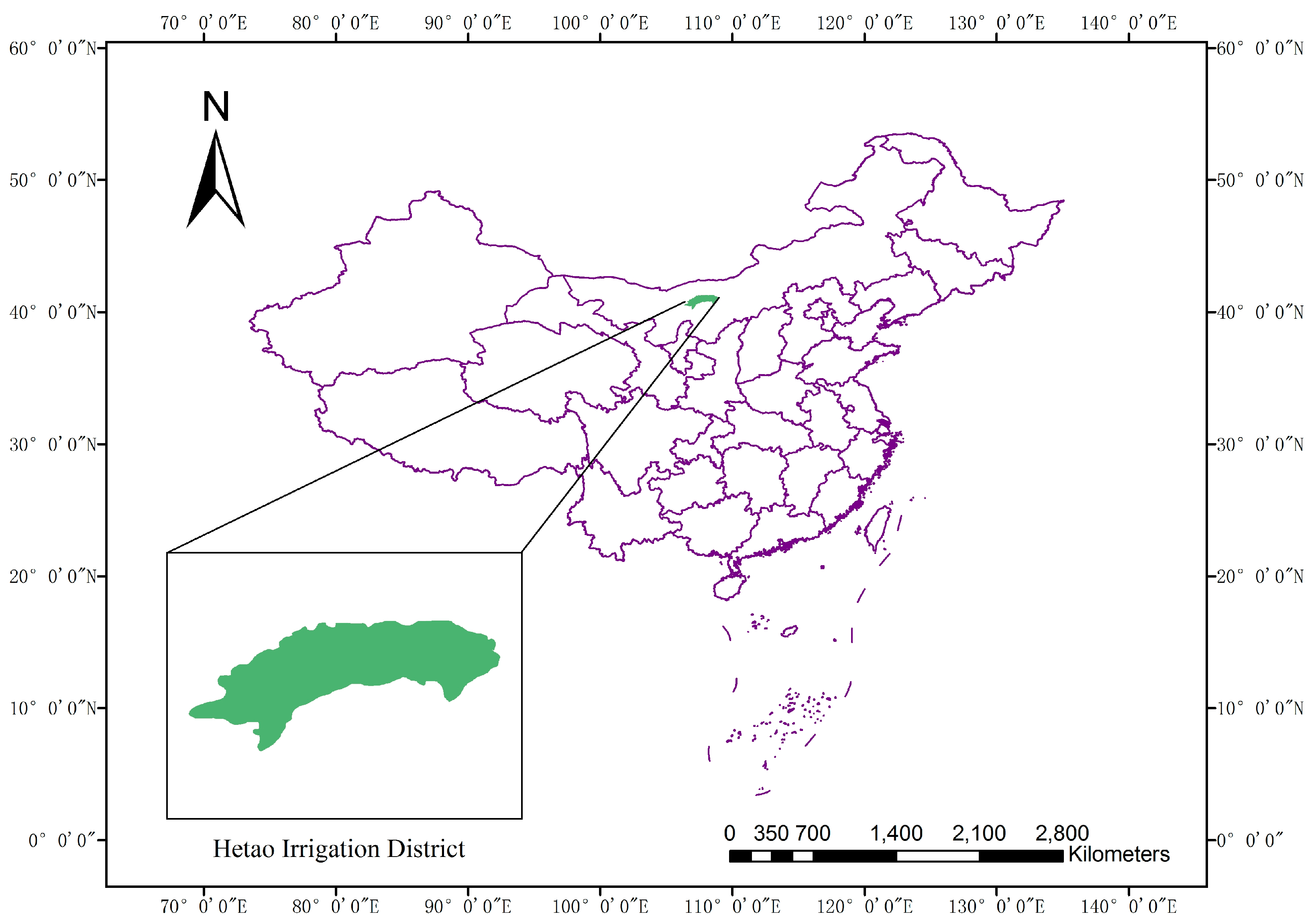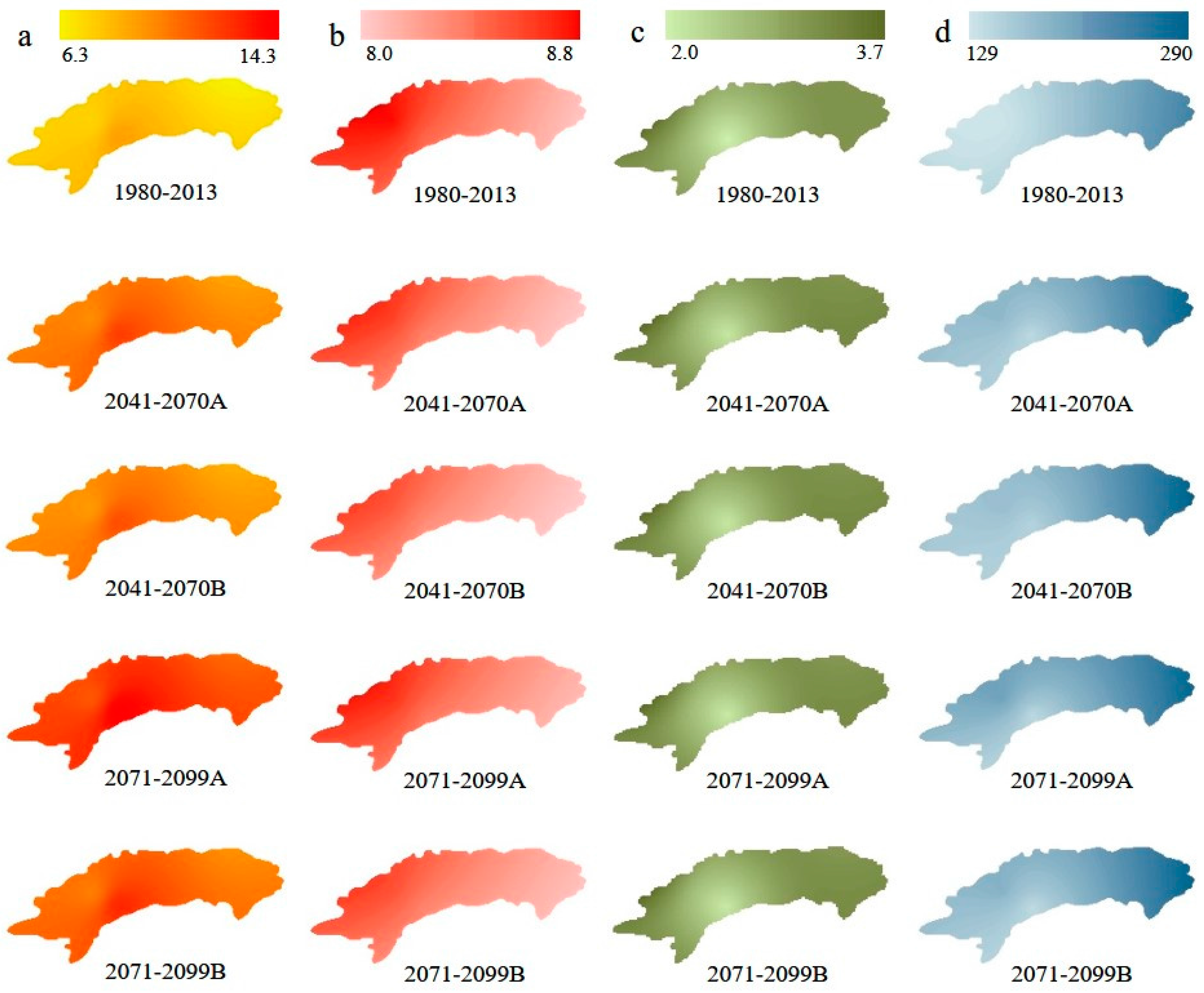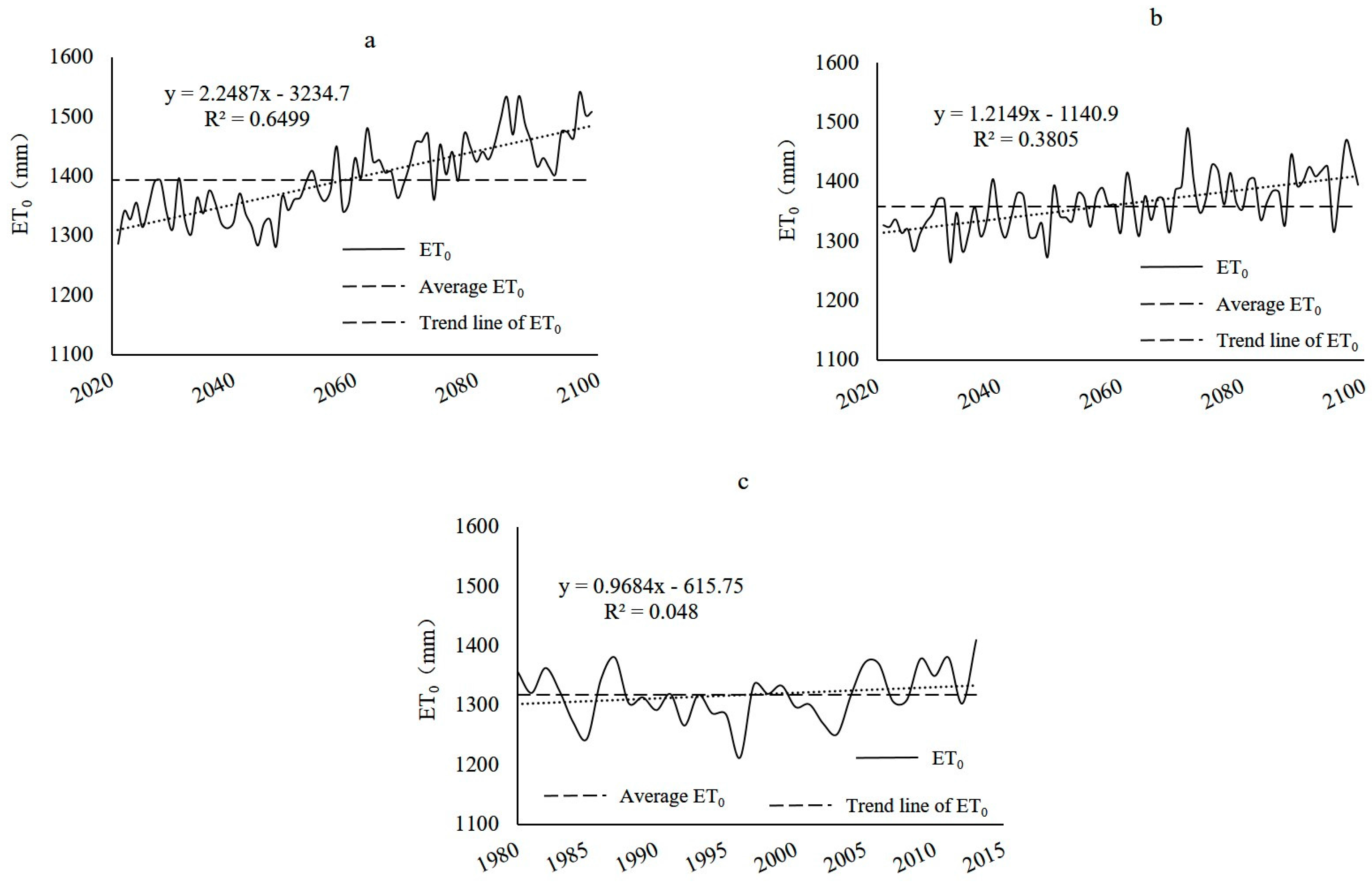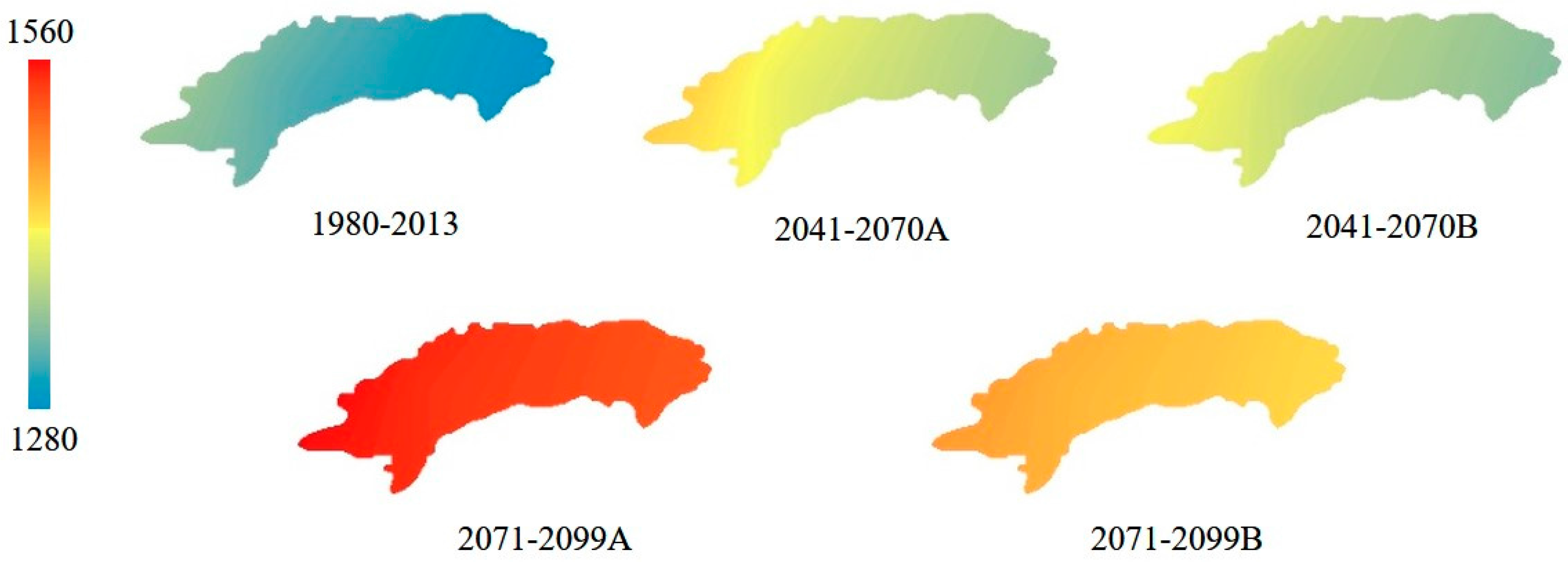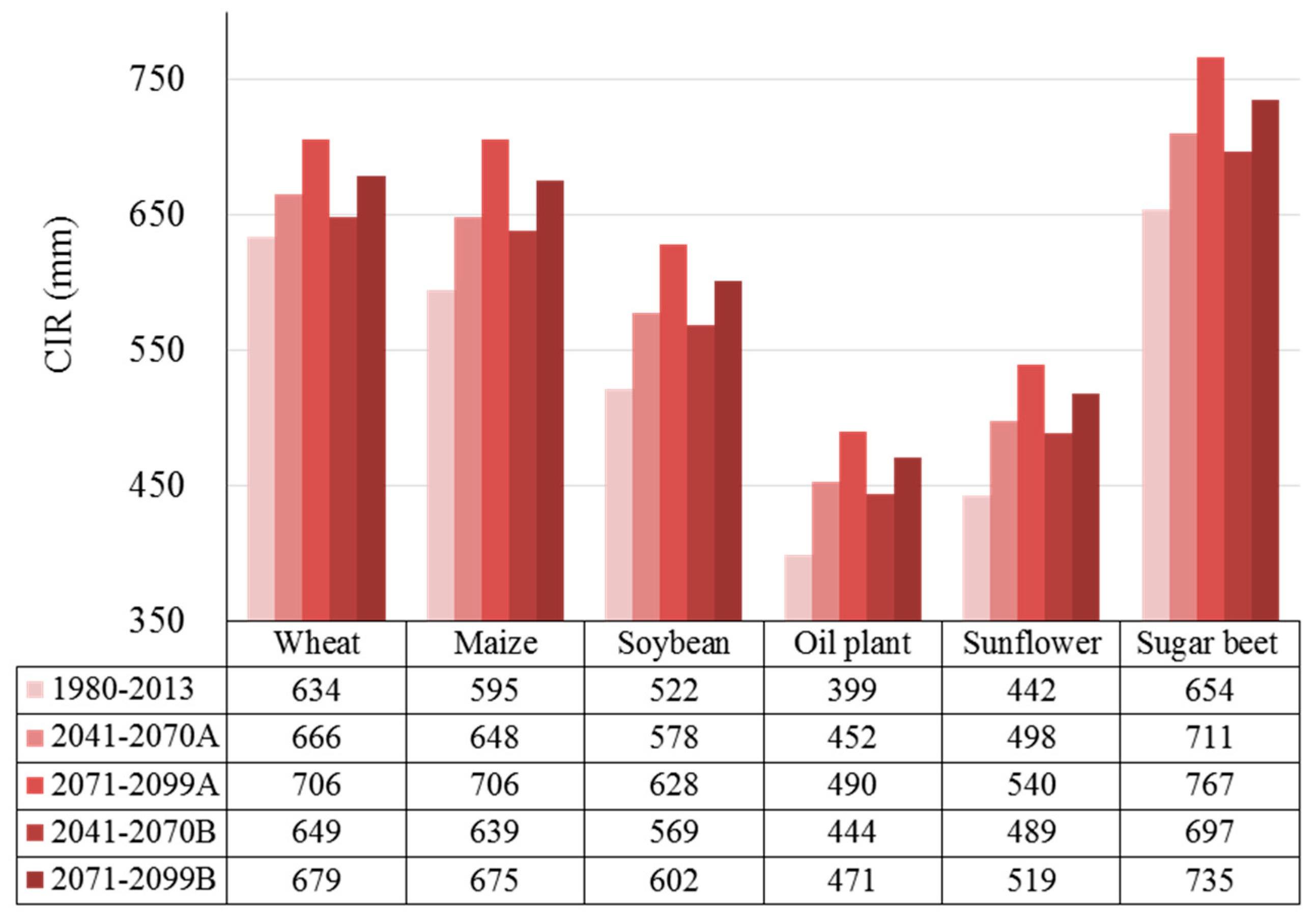1. Introduction
According to the Assessment Report 5 of the Intergovernmental Panel on Climate Change (IPCC), the global surface temperature has increased by 0.65–1.06 °C during the years 1880–2012, and the rate of the temperature increase after 1951 has been approximately 0.12 °C per 10 years, which is almost twice the rate since 1880. Furthermore, it is predicted that by the end of the 21st century (2081–2100), the average global surface temperature will be 1.5–2.0 °C higher than that in the years 1850–1900 [
1,
2]. Climate change could not only affect global food production and supply [
3], but can also impact the quality and safety of agricultural products [
4,
5]. Therefore, the world’s Food and Agriculture Organization (FAO) has made it a worldwide challenge to cope with climate change when solving world’s food supply problem and relieving hunger [
6]. Climate change would have impacts on crop growth and water consumption pattern, as well as the quantity of irrigation water that crops require to grow well [
7,
8,
9]. Exploring the changes in crop water requirement (CWR) and crop irrigation requirement (CIR) under the climate change circumstance could provide a theoretical basis for the design of irrigation water conservation facilities and agricultural water resources management.
General circulation models (GCMs) can simulate the important characteristics of future climate on a large scale very well in the study of regional climate change; however, the GCMs have limited value because they have a low spatial resolution and lack the regional climate information. Currently, there are two ways to make up for the inadequacy of GCMs in predicting regional climate change: one is to develop new GCMs with higher resolution, and another is to downscale GCMs to the regional scale. Due to the large amount of calculation required to improve the spatial resolution of the GCMs, downscaling techniques have gained in popularity [
10]. Downscaling techniques can be further divided into dynamical downscaling and statistical downscaling. Dynamical downscaling is actually to build a regional climate model which has a clear physical meaning and will not be affected by the observation data; however, it also has some disadvantages. For example, it requires significant computing resources and is not readily transferred to new regions or domains. Statistical downscaling is based on the view that the regional climate is conditioned by the large-scale climatic state and local physiographic features. From this perspective, regional climate information can be derived from a statistical model which relates large-scale climate variables to regional variables. Although this method cannot be interpreted physically, it is computationally inexpensive and can be used to provide site-specific information. Statistical downscaling techniques are also widely used because they include three major types of methods (i.e., weather classification, regression models, and weather generators [
11,
12]), providing more choice to its users.
The studies of the impact of climate change on reference crop evapotranspiration (ET
0) have different results in different study areas. Reference [
13] used the LARS-WG (Long Ashton Research Station-Weather Generator) to generate future climate data in Suwon, South Korea, and found that the ET
0 during the years 2080–2099 would be nearly 100 mm larger than of 1973–2088. In reference [
14], the future ET
0 in Puerto Rico was calculated, and the results show that the ET
0 would keep an upward trend in the following 100 years under A2 scenario. The generalized linear model (GLM) was used in reference [
15] to estimate the future ET
0 in the UK, and the results indicate that the southern part of the UK will be more sensitive to the change in ET
0 than the north. Reference [
16] downscaled ET
0 during 2011–2099 from HadCM3 (Hadley Centre Coupled Model, version 3) outputs by SDSM (Statistical DownScaling Model) in the Loess Plateau of China, finding a continuous increase and a possible increasing gradient from northeast to southwest region in ET
0 in the 21st century. These theses mainly focus on the variations of the temporal and spatial aspects of future ET
0, but they pay less attention to how the change of ET
0 would affect the agricultural water use.
The Hetao irrigation district (HID) is one of the largest irrigation districts in addition to being an important commodity grain production base in China. It is of great significance to study how the climate, the future ET0 and CWR of HID would change, because the study would guide agricultural production planning in this area. This paper adopts two emission scenarios released by the IPCC; i.e., A2 (under this scenario, the global population continues to increase, and the economy grows rapidly) and B2 (under this scenario, the growth of population is slower than under A2, and a sustainable development strategy is adopted), and then use the Statistical DownScaling Model (SDSM) to predict main meteorological parameters in the time periods 2041–2070 and 2071–2099 in the HID under scenarios A2 and B2. The change of each parameter in the future are analyzed, and the future ET0 and crop evapotranspiration (ETc) of HID—which can provide a reference for the agricultural production—are calculated and analyzed.
3. Results
3.1. Temporal and Spatial Analysis of Meteorological Parameters
The average value of each parameter and their spatial distribution in different time periods are shown in
Table 2 and
Figure 2, respectively.
In the last decades of 21st century, the Tmin and Tmax of HID under scenario A2 would rise to 5.4 and 18.5 °C, respectively, and the average temperature is about 4 °C higher than the present stage. Temperature under scenario B2 increases relatively less with the increment 4.2 and 17.1 °C respectively—3 °C higher than the present stage. In terms of the SH, the phenomenon shows under both scenarios that during the years 2041-2070 the SH reaches its lowest value, while in the years 2071–2099 the value goes up but is still lower than that of the present stage. The SH under scenario A2 is longer than that under B2 scenario during the same time period, and the SH during the years 2041–2070 under scenario B2 is the lowest with only 8.5 h, which is 1.28% lower than that of the present stage. The precipitation in the years 2041–2070 and 2071–2099 does not have much difference under A2 or B2 scenario, but compared with the value of the present stage, P would increase by about 20 mm under scenario B2 and just a little bit less under A2. The wind speed and relative humidity in HID would not change significantly. Overall, the climate in HID would get warmer and wetter.
In terms of the spatial distribution, the maximum average annual temperature is 9.2 °C, which shows in the southern of the middle of HID during the present stage, and the minimum shows in western and northern of HID. The WS has a spatial distribution contrary to that of temperature, and its highest value is 3.5 m·s−1 and lowest 2 m·s−1 during the present stage. The SH peaks at 8.8 h during the present stage in the northwestern part of HID, while in the east the value shrinks down to just over 8 h; its spatial distribution shows a trend of decreasing from west to east, which is opposite to the distribution of precipitation whose lowest value is only 129 mm, shown in the west, and highest value is more than 240 mm, shown is the east. In the future, the spatial distribution of precipitation would change slightly with a decreasing trend in the middle area of HID, and it is more distinct under scenario A2. The spatial distribution pattern of other parameters does not change much, but the range of the values would change—especially the value of temperature, which will increase notably.
3.2. Temporal and Spatial Analysis of ET0
The change of meteorological parameters will cause a change in ET
0.
Figure 3 shows that during 1990–2003, the ET
0 was below or just slightly above the average ET
0 (1318 mm), while after 2003 the phenomenon reversed and in most years the ET
0 was much higher than the average value. The climate inclination rate during the present stage is 11.5 mm per 10a, which means, on average, the ET
0 rose 1.15 mm per year during this period of time. However, in the future (2021–2099), the average increment of ET
0 is 2.28 mm per year under scenario A2, which is almost twice the present increasing rate; the rate under scenario B2 is 1.23 mm per year. ET
0 would increase by 6.09% and 12.19% during the years 2041–2070 and 2071–2099, respectively, under scenario A2. The increase trend is the same under scenario B2, wherein the growth rate would increase over time, and the increments during the years 2041–2070 and 2071–2099 are 3.88% and 7.48%, respectively. Based on the fact that SH, WS, and RH would not change much in the future while the temperature would rise, it can be concluded that the increase of ET
0 is mostly affected by the increase of temperature in HID. The temperature would maintain the growing trend in the future and would be higher under scenario A2 than under B2, and thus so would ET
0. The spatial distribution of meteorological factors that affect ET
0 would remain almost the same (
Figure 2), so it is deducible that the spatial distribution of ET
0 would hardly change (
Figure 4). The highest value of ET
0 shown in the west of HID and the lowest value in the east of HID.
Overall, with the change of meteorological parameters, ET0 in HID would continue to grow, which would cause a rise in CWR and further influence the hydrologic cycle, water balance, and agricultural production in the district.
3.3. Future Crop Water Requirement in Potential Climate Scenarios
ET
c is closely correlated with ET
0, and indicates the amount of water that a type of plant needs during its growth season (i.e., CWR in this case).
Figure 5 shows the ET
c of six main crops grown in HID. Owing to the different growing periods and K
C, the ET
c of the six crops are different.
In terms of growth duration, maize is the longest among the six crops, followed by sugar beet. However, due to a higher KC, the ETc of sugar beet takes the first place, with 794 mm. The ETc of wheat, soybean, sunflower, and oil plant are reduced in turn, which is positively correlated with the growth duration of crops. The ETc of oil plant is the lowest with 516 mm, which is only 65% of that of sugar beet. The ETc of six crops all have the same temporal tendency as ET0, which means the future ETc would grow over time and the increment under scenario A2 would be more distinct. However, because of the difference in the growth season, the increment of ETc of the six crops are different, and when sorted in a descending order, it would be wheat, sugar beet, maize, soybean, sunflower, and oil plant. The increment of ETc of the six crops are the smallest during the years 2041–2070 under scenario B2, with 3.4–7.3%, and the largest during the years 2071–2099 under scenario A2, with 10.5–15.2%. So, the ETc of the six crops would grow as time passes, and the CWR in HID would increase.
3.4. Future Crop Water Irrigation Requirement in Potential Climate Scenarios
CIR is the quantity of additional water needed by crops via irrigation, beyond precipitation, to satisfy the crop’s growing period water requirements and guarantee their yield. A careful calculation of CIR is important in guiding the construction of water conservancy facilities and the management of water resources. This paper estimated the total CIR of the main crops grown in HID based on current sown area of crops.
It can be seen from
Figure 6 that the PE of 6 crops mainly show a downward trend, and the reduction is greater during the year 2071–2099. Because maize and sugar beet have similar plant and harvest dates (which means the length of their growth season are alike), the PE and reduction of PE during their growth season are almost the same, with 9 and 2 mm reduction during the years 2071–2099 under scenarios A2 and B2, respectively. Wheat ranks the third in the length of the growth season among these crops, but because of the earliest plant data which is in the dry season of the district, wheat has the lowest PE during the growth period, and even if it is the only crop whose future PE during the growth period would increase (about 5 mm under scenario A2 and 10 mm under scenario B2), its rank would not change. The length of the growth period of soybean, sunflower, and oil plant are reduced in turn, and so too are their PE during growth season. The reduction of PE of sunflower and oil plant during their growth season are the largest, with 12 mm under scenario A2 and 8 mm under scenario B2.
Due to the joint influence of increased ET
c and decreased PE during the growth season, the future CIR would show an upward trend (
Figure 7). The irrigation requirement of sugar beet is the largest among the six crops, and would show the largest increment. The increment would be 57 and 43 mm during the time period 2041–2070 under scenarios A2 and B2, respectively, and 113 and 81 mm during the time period 2071–2099 under scenarios A2 and B2, respectively. The PE of wheat during its growth period would increase, but the increment cannot compensate the increment in water demand of wheat, so the irrigation requirement of wheat shows an upward trend. The irrigation requirement of wheat would increase by 5–11% under scenario A2 and 2–7% under scenario B2.
Assuming the planting area of crops remain the same, this paper calculated the total CWR and CIR in HID during different time periods, and the results are shown in
Table 3. The total CIR of HID is about 2.3 × 10
9 m
3 during the present stage, while under scenario A2 it would increase by 10.4% and 19.7% during the years 2041–2070 and 2071–2099 respectively, and under scenario B2, the increase during the years 2041–2070 and 2071–2099 would be 8.5% and 14.8%, respectively. Generally speaking, the changes of CWR and CIR have the same pattern, which is that the increment under scenario A2 is greater than under scenario B2, and greater during the years 2071–2099 than during the years 2041–2070. Furthermore, the increment would increase with the passage of time, which would bring HID an increasing pressure in water resource and a serious challenge in meeting the amount of water that crops need.
4. Discussion
According to the IPCC, it is almost certain that the global temperature and precipitation will rise in the future [
2]. In the past few decades, researchers have pointed out that the temperature and precipitation have shown an increasing trend in Western China [
28,
29,
30,
31], and indicate that there is a chance that the climate in Western China will be warmer and wetter [
32,
33]. The results of this paper show that regardless of the climate scenario (A2 or B2), the temperature of HID would rise apparently and the future precipitation in HID would also increase, while the temperature increase would be greater under scenario A2 and the precipitation increase would be greater under scenario B2. The results indicate that the future climate of HID would be more hot and humid, which correspond with the results of others.
The results in
Section 3.4 of this paper show that in spite of an increasing trend in annual precipitation, the PE during crop growth season would decrease. It can be learned from
Figure 8a that the future precipitation mainly grows between March and July, and the month with largest precipitation would advance from August to July, and the future precipitation would be equal to or less than that of present after August. That is to say, the rainy season of HID would come earlier. However, the growing season of crops in HID is between April and September; furthermore, the growing season of sunflower and oil plant—whose sown area rank currently first among crops planted in HID—are mainly during June to September. The advance of rainy season leads to a discrepancy between growing season and rainy season, which means less precipitation during the crops’ growing period, and that is why the annual precipitation would increase while the PE of crops would decrease.
At the same time, the future ET
0 would be greater (
Figure 8b). Apart from the ET
0 during the years 2041–2070 under B2 (whose value in April and May is slightly less than that of current day), the increase is mostly between April and September, which is the time period of the growth season of HID. The distribution of ET
0 in every month under A2 and B2 have not much difference until the years 2071–2099, when the monthly average increase is 21 mm under A2 and 13 mm under B2. So, in the future, during the growth season of HID, the ET
0 would be greater while PE would be less, which contributes to an increase in CIR and would bring an adverse condition to the agricultural production in HID.
Compared with B2, scenario A2 has a greater greenhouse gas emission, and the increment of temperature and ET0 under A2 would correspondingly be larger than under B2. With the increment of precipitation less than 20 mm, the pressure on agricultural production under A2 would be greater. It is required in the national comprehensive planning of water resources that by the year 2030, the irrigation water use efficiency should reach 0.60. So, calculations of the amount of water should be derived based on this regulation; the best condition is during the years 2041–2070 under B2, and 4.2 × 109 m3 of water should be derived; the worst condition is during the years 2071–2099 under A2, and 4.6 × 109 m3 of water should be derived. According to the water allocation set by the country, HID is allowed to derive 4 × 109 m3 of water from the Yellow River, and the quota might be lower in the future. So, there would be a non-negligible gap between the water need and supply, which will threaten the agricultural production.
Some drawbacks of this study may be objects of future investigation. Although SDSM is a reliable tool in downscaling, it has no physical meaning, and the details for changes of parameters cannot be known. Many studies suggest that [
34,
35] ET
0 has been changing periodically. This research is based on a 34-year period of time, which is not long enough to study the cycle of ET
0 in HID, and if it does have a cycle at the present stage, whether or not the future ET
0 will have the same cycle is not taken in to account.
5. Conclusions
The future sunshine hours of HID would be slightly lower, while the precipitation would increase. The average temperature would rise as time goes on, and the increase is greater under scenario A2. The spatial distribution of parameters would not change much. Hetao irrigation district will experience a warming and wetting climatic pattern in future.
ET0 is 1318 mm at present stage, and would increase by 7.14% and 4.48% during 2021–2099 under scenarios A2 and B2, respectively, and it increases predominantly throughout the growth period of crops. The main reason for the rise of ET0 is the rise of temperature. The spatial distribution of ET0 remains the same as the present stage, which reduces from west to east.
ETc and PE during crop growth season have a positive relationship with the length of the growth season of crops, but ETc shows an increasing trend while PE a decreasing one. The increment of ETc under A2 is greater than that under B2. The advance of the rainy season in the future is the major reason for the reduction of PE, and with the coefficient of the increasing of ETc and decreasing of PE, CIR during the years 2071–2099 would increase by 19.7% and 14.8% under scenarios A2 and B2, respectively.
